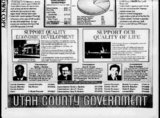| OCR Text |
Show Mapleton TTr has f history of community spirit r i rich By LAUREL BRADY Special to the Daily Herald The more things change, the more ihey stay the same. That residents of the small city of Mapleton still fight the same battles their loreiameis i cviucnt old Bird Home, and converted iuu$;iu during a vis-- to the now being restored into a museum. t I '( There, one can trace the city's history through the myriad of old photographs lining the walls, or peruse city history spirit of community and that helped the town to cooperation flouish and deliver a pleasant lifestyle while some of its children went on to accomplish important things. The area at the base of "Sierra Bonita." or Maple Mountain, was considered desirable as early as the 1850s. but the lack of water and the difficulty of rubbing shoulders with inhabitants native discouraged growth for many years. The bench area was utilized mostly for grazing by Springville farmers who quickly learned not much could be accomplished there without a spirit of full cooperation among neighbors. Early farming attempts failed, until families combined their efforts to maintain livestock and raise a few crops. Crops were finally grown successfully and a permanent town was established about V-- ti. it was first known as Union Beri :n recognition of the cooperation that made it possible. Residents later voted to call the area Mapleton, although it did not become a separate city until 1902. That it became separated from Springville at all was largely due to conflicts over water and infrastructure. Mapieton residents felt slighted by Springville officials when it was felt they were not placing as high a priority on constructing improvements such as roads and bridges as they should. over water rights between the two entities continued until construction of the Strawberry tunnel placed Mapleton in an excellent bargaining position and Springville authorities realized compromises would benefit both towns. Not surprisingly, the heavy influence of the LDS Church also played a large role in Mapleton's autonomy, fam-"lialthough a number of non-LD- S had come to the area by the turn of the century. Residents of several religions were comfortably, enjoying mutual benefits through diversity when Mapleton finally achieved independence. From the start it was said, Mapleton is a great place to live and a Poor place to make a living." The es scattered retail j.j 'SSl S books to see how history repeats itself. A main theme, both of the old pictures and any current city council meeting, is the continuing Disputes : conditions discouraged merchants and only a few sec- - Ji ; r (7 Photo courtesy of G.E. Anderson water from an irrigation ditch. Damage was estimated at $49.25. A Mapleton church fire was extinguished fast thanks to the quick efforts of the bucket brigade which carried ondary occupations were in demand, or are in demand today. business and a store were about the only industries that could survive, but even during the depression, residents found resourcefulness and cooperation their greatest survival skills. Volunteer efforts still flourish today, evidenced by the current city hall constructed largely through volunteer labor, the thriving recreation citprograms, ambulance service and izen boards that continue the struggle to grapple with growth and revenue problems. Many residents take pride in their live on pioneer ancestry and still farmland their carved out of dry wilderness. it is Farming is still difficult, but now due to economic rather than irrigation difficulties. Orchards and fields are increasingly being converted to residential housing, as many farmers with old Mapleton names are facing the reality the city's agricultural days are almost gone. A citizen volunteer group manthe edge of ages the Bird Home on mainresidents the city park, helping Since being the tain ties to past. home has the the city, acquired by with historic gradually been filling Because artifacts. and photographs roots, they common so many share histories their family's trace can showthrough the photos on display still standing, ing original homes reunions, graduations, civic events and even personal stories. Farm-relate- d what's in it for you? is one of tin' in.iny important you should iisK when you iiici'l Willi .in insurance agent. As ii New York Lite agent. I welcome your questions, because there's no reason why you shouldn't risk me as i it it h This alKiiii iMinesily. and ilvey've come to trust me. Call me today, and let ine show you why New York Life is The Company You Keep. inyseHastaskalxMit you. in order lo help you plan a financial I have to ask you a lot of strategy. questions. Inn eeci you lo ask me jusl as many. Questions like what sort of polii ies do you own'.'" and How do you get paid'.'" I've liuilt manv relationship with my clients by answering their questions I long-ien- Marilyn CUyson Santaquin Office Bruce Bowen, CLU American Fork Office Curtis Otsen Art Sandgren 'J Steve Holley Doug Nidiolci PROVO OFFICE 3305 No. University Ave, Suite 100 The Company You Keep" 1994 n- Your Life 373-592- 6 insurance 53 |



























































































































































































































